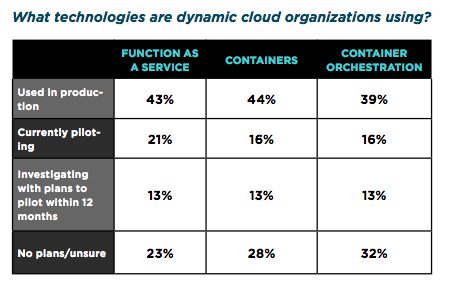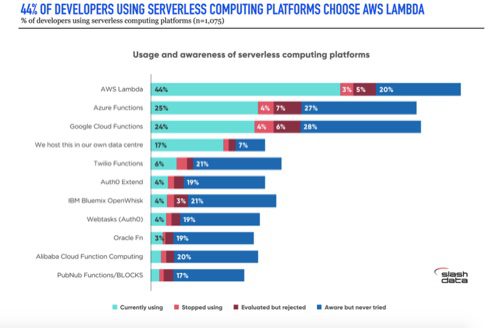It’s safe to assume that serverless cloud computing adoption rates are heading up toward, well, the clouds. (Sorry, I couldn’t resist.) But various surveys – see below – show that serverless is still a nascent tool in cloud development.
First, some backstory. Hype abounds in the coverage of serverless and the wonders that it works. Adopting serverless lowers costs, speeds deployment, increases scalability, decreases management time. It might even help you cook the perfect egg.
Protecting your company’s data is critical. Cloud storage with automated backup is scalable, flexible and provides peace of mind. Cobalt Iron’s enterprise-grade backup and recovery solution is known for its hands-free automation and reliability, at a lower cost. Cloud backup that just works.
Significantly, serverless supports microservices and DevOps. And it’s beloved by developers, who have an outsized role in driving tech adoption.
As serverless gains steam, some observers opine that there’s a serverless vs. container debate. Yet certainly containers will be a factor for the foreseeable future. If you doubt that, check this nugget from Bernard Golden on A Cloud Guru. He noted that Tim Wagner, general manager of AWS’s serverless platform Lambda, “acknowledged the widely held suspicion that Lambda operates by dynamically loading containers and running the code inside of them.”
The word “dynamic” is key here. Serverless is a dynamic system of allocating the exact level of compute resources needed for an application in the cloud – no more, no less. A developer’s code triggers a function that is executed with the precise resources. Hence the name, Functions as a Service, FaaS.
Cloud already lessened the headaches of managing your tech platform; serverless reduces the burden even more. Plus you’ll hear countless stories of cloud customers using serverless to lower costs. Fewer virtual machines are spun up and not used.
So given that serverless is a huge step forward in cloud, has everyone rushed to adopt it?
A number of surveys look at serverless adoption from various slants. None yet provides a comprehensive survey of overall adoption rates.
This is likely due to the relative newness of serverless. AWS debuted serverless in late 2014 with the launch of Lamba. The competing cloud vendors all jumped on board in 2016: IBM offers Cloud Functions (based on OpenWhisk), Microsoft has Azure Functions, Google touts its Cloud Functions. Expect an ecosystem to thrive around these main tent poles. For instance, IOpipe is a metrics and monitoring service for Lambda. Bitnami’s Kubeless enables applications with FaaS on top of Kubernetes.
Cloudability’s State of the Cloud 2018 report, with data from 1500 organizations, shows serverless adoption growing by exponential leaps and bounds. Yet the report doesn’t reveal the absolute baseline number of customers using serverless, so the hypercharged percentage jumps don’t necessarily indicate great overall adoption.

Cloudability spotlights growth rates in use of AWS Lamba and Azure Functions, which are currently the leading serverless providers.
Looking big picture, Cloudability says that “cloud adoption has only scratched the surface in the IT infrastructure market; it’s estimated that only 10% of all workloads have moved to the cloud…it’s clear that ‘lift-and-shift’ migrations continue to dominate cloud adoption.”
The lift and shift crowd (a simple move to the cloud with little re-architecting) are not big users of serverless, so this suggests low FaaS adoption.
A New Relic report from Feb 2017, Achieving Serverless Success with Dynamic Cloud and Devops, surveyed 500 people knowledgeable about their organization’s cloud strategy. The report divides respondents between “dynamic cloud” users (who use tools like DevOps and containers) and “static cloud” users (who are merely lift and shifters). It’s not clear from the report what percentage of users are dynamic and which are static. However, “relatively few respondents report that the majority of their strategic workloads are currently running completely in the public cloud.”
Of dynamic cloud users, 43 percent are using serverless in production. Which means that less than half of even the forward-looking cloud users have adopted serverless.

The New Relic report indicates that container use and serverless use are essentially equal among advance cloud customers.
New Relic reports that serverless is still the province of the early adopters: some 13% of dynamic users are merely “investigating” serverless, and 23% aren’t thinking about serverless at all.
Surely serverless adoption has risen in the year since the report. But still, these numbers say that serverless remains closer to nascent than established.
More recently, Slashdata’s State of the Developer Nation, from Q417, surveyed almost 22,000 developers across the globe. The report shows – no surprise – that AWS Lamba holds the largest market share among developers who use serverless. Given that Azure and Google Cloud both launched their serverless platform after AWS’s, this race may be closer than it appears.

The State of the Developer Nation report shows the broad cross section of serverless offerings.
The report notes: “More than 60% of all serverless users are aware of at least the top three vendors.” Yet this actually suggests remarkably low awareness. Almost 40 percent of developers didn’t know – as recently as Q417 – that all three major cloud vendors offer FaaS. This is still a very new market.
Also notable: beyond the top three cloud vendors, the most common adoption platform for serverless is “we host this in our own data centre.” Who says private cloud is dying?
Developer Nation notes that 19% of backend developers are using serverless, about the same as the 20% who use VMs on IaaS.
The report makes a key point: serverless is geared for new apps that have been coded for it. It isn’t a natural fit for the legacy apps that make the world go round. This puts a ceiling on current severless adoption, though it suggests future growth as more new apps are coded with serverless in mind.
Finally, a look at revenue numbers reveals the sharpest uptrend for serverless. A report on ResearchAndMarkets.com, from February 2017, estimates that the FaaS market will grow from $1.88 billion in 2016 to $7.72 in 2021 – a blistering compound annual growth rate of 32.7%.
The report references a central complaint about serverless, that the top cloud vendors are developing serverless with an eye toward vendor lock-in; the various system aren’t interoperable. It notes: “application portability issues on cloud environments acts as a major restraint in the overall growth of the [FaaS] market.”
It’s slightly odd that the report refers to “FaaS vendors,” a category that in 2018 isn’t top of mind for customers. Is there a single customer out there who says to themselves, “We need a FaaS vendor – let’s shop for one.” Probably not. Serverless is still seen as an add-on feature to the larger purchase decision.
At any rate, here’s the report’s list of FaaS vendors:
1. IBM (U.S.)
2. Google Inc. (U.S.)
3. Microsoft Corporation (U.S.)
4. Amazon Web Services(U.S.)
5. SAP SE (Germany)
6. Dynatrace LLC (U.S.)
7. Infosys Ltd. (India)
8. Rogue Wave Software Inc. (U.S.)
9. TIBCO Software Inc. (U.S.)
10. Fiorano Software and Affiliates (U.S.)
Huawei’s AI Update: Things Are Moving Faster Than We Think
FEATURE | By Rob Enderle,
December 04, 2020
Keeping Machine Learning Algorithms Honest in the ‘Ethics-First’ Era
ARTIFICIAL INTELLIGENCE | By Guest Author,
November 18, 2020
Key Trends in Chatbots and RPA
FEATURE | By Guest Author,
November 10, 2020
FEATURE | By Samuel Greengard,
November 05, 2020
ARTIFICIAL INTELLIGENCE | By Guest Author,
November 02, 2020
How Intel’s Work With Autonomous Cars Could Redefine General Purpose AI
ARTIFICIAL INTELLIGENCE | By Rob Enderle,
October 29, 2020
Dell Technologies World: Weaving Together Human And Machine Interaction For AI And Robotics
ARTIFICIAL INTELLIGENCE | By Rob Enderle,
October 23, 2020
The Super Moderator, or How IBM Project Debater Could Save Social Media
FEATURE | By Rob Enderle,
October 16, 2020
FEATURE | By Cynthia Harvey,
October 07, 2020
ARTIFICIAL INTELLIGENCE | By Guest Author,
October 05, 2020
CIOs Discuss the Promise of AI and Data Science
FEATURE | By Guest Author,
September 25, 2020
Microsoft Is Building An AI Product That Could Predict The Future
FEATURE | By Rob Enderle,
September 25, 2020
Top 10 Machine Learning Companies 2020
FEATURE | By Cynthia Harvey,
September 22, 2020
NVIDIA and ARM: Massively Changing The AI Landscape
ARTIFICIAL INTELLIGENCE | By Rob Enderle,
September 18, 2020
Continuous Intelligence: Expert Discussion [Video and Podcast]
ARTIFICIAL INTELLIGENCE | By James Maguire,
September 14, 2020
Artificial Intelligence: Governance and Ethics [Video]
ARTIFICIAL INTELLIGENCE | By James Maguire,
September 13, 2020
IBM Watson At The US Open: Showcasing The Power Of A Mature Enterprise-Class AI
FEATURE | By Rob Enderle,
September 11, 2020
Artificial Intelligence: Perception vs. Reality
FEATURE | By James Maguire,
September 09, 2020
Anticipating The Coming Wave Of AI Enhanced PCs
FEATURE | By Rob Enderle,
September 05, 2020
The Critical Nature Of IBM’s NLP (Natural Language Processing) Effort
ARTIFICIAL INTELLIGENCE | By Rob Enderle,
August 14, 2020

Datamation is the leading industry resource for B2B data professionals and technology buyers. Datamation's focus is on providing insight into the latest trends and innovation in AI, data security, big data, and more, along with in-depth product recommendations and comparisons. More than 1.7M users gain insight and guidance from Datamation every year.
Advertise with TechnologyAdvice on Datamation and our other data and technology-focused platforms.
Advertise with Us
Property of TechnologyAdvice.
© 2025 TechnologyAdvice. All Rights Reserved
Advertiser Disclosure: Some of the products that appear on this
site are from companies from which TechnologyAdvice receives
compensation. This compensation may impact how and where products
appear on this site including, for example, the order in which
they appear. TechnologyAdvice does not include all companies
or all types of products available in the marketplace.